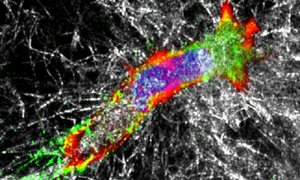
About our equipment
Multi-photon excitation microscopy (MPM) is the approach of choice for fluorescence imaging of living three-dimensional tissue at subcellular resolution for up to one millimeter in depth. read moreAbout our equipment
Multi-photon excitation microscopy (MPM) is the approach of choice for fluorescence imaging of living three-dimensional tissue at subcellular resolution for up to one millimeter in depth. The PRIME Nijmegen MPM setup consists of two TriMScope-II microscopes (LaVision Biotec, Germany), it incorporates three fs-pulsed excitation sources (Chameleon Ultra, Coherent) and an optical parametric oscillator (Coherent-APE) to excite samples with two near infrared and one infrared wavelength simultaneously.Technical Details about MPM
The MPM in PRIME has up to 7 non-descanned detection channels available in the backward and forward direction. read moreTechnical Details about MPM
The MPM in PRIME has up to 7 non-descanned detection channels available in the backward and forward direction, including two 16-channel time domain fluorescent lifetime detectors for intravital fluorescent lifetime imaging. Infrared (IR-)MPM reaches up to 10-fold improved excitation of far-red fluorophores (e.g. DsRed, mCherry), two-fold tissue penetration, reduces photobleaching 4-10 fold and minimizes phototoxicity, compared with conventionally used near-infrared excitation (Andresen et al. , 2009), thus maximizing sample volume and biocompatibility during intravital microscopy.
Visualization of signals with MPM
IR-MPM in PRIME allows to visualize several types of signals from live tissues by simultaneous detection. read moreVisualization of signals with MPM
IR-MPM in PRIME allows to visualize several types of signals from live tissues by simultaneous detection:- Fluorescence intensity of blue, green, red and far-red probes and proteins;
- Second harmonic generation by collagen and actomyosin in mascle fibers;
- Third harmonic generation of interfaces between (bio)materials with different optical properties, including nerve cells, blood cells and intra-extracellular boundaries (e.g. lipid bodies, cell fragments);
- Fluorescence lifetime of fluorescence emission from single- and multi-spectral samples, including autofluorescent drugs and molecular FRET/FLIM reporters.
Applications in PRIME
Several applications of IR-MPM are established at Radboud PRIME for live-cell and animal studies. read moreApplications in PRIME
The following applications of IR-MPM are established at Radboud PRIME for live-cell and animal studies:- Repetitive and time-imaging of relatively easy accessible organs, including dermis, breast, brain and lymph nodes in mice and rats using window models; monitoring of dynamics of tumor growth/proliferation, invasion, density and perfusion of blood vessels; repeated imaging intervals range from seconds up to weeks. Multiphoton imaging can be implemented as a part of a multimodality imaging experiment using custom MRI/RET compatible window models.
- Endpoint imaging of deeper organs like spleen and liver after one-time surgery.
- The response of different (tumor) regions to therapeutic interference, including apoptosis, necrosis, tumor volume change, resorption of tumor cells, vascular response (angiogenesis, vessel occlusion/remodeling).
- Co registration of functional parameters after application of functional reporter probes, such as FRET-based probes, intracellular Ca2+, pH, and blood perfusion/clotting, using FLIM and FRET/FLIM.
- Imaging of fixed tissue samples to co-register immunostaining and unlabeled structures like fat cells, nerves, muscle fibers, fibrillar collagen.
- Two-photon excited laser microsurgery of cells and tissues (3 µm precision).
- Monitoring of cancer invasion and leukocyte dynamics in thick organotypic 3D cultures (spheroid assay, organ-slice cultures).
- 3D image reconstruction, image segmentation and quantitation using standard software (Fiji/ImageJ, Imaris, Volocity, Imspector) and/or customized routines (C++, Matlab).

